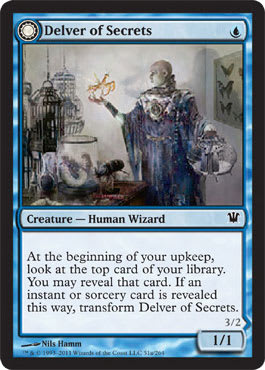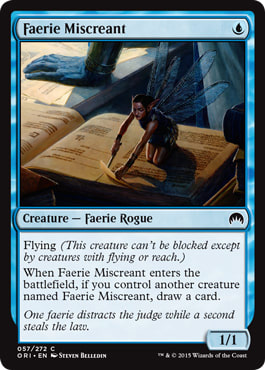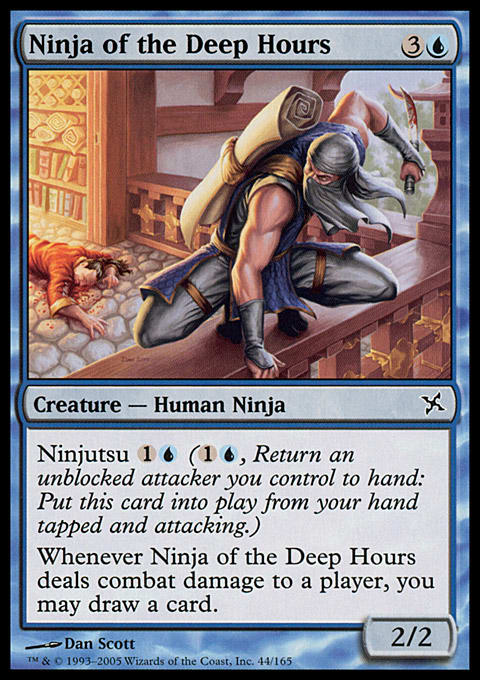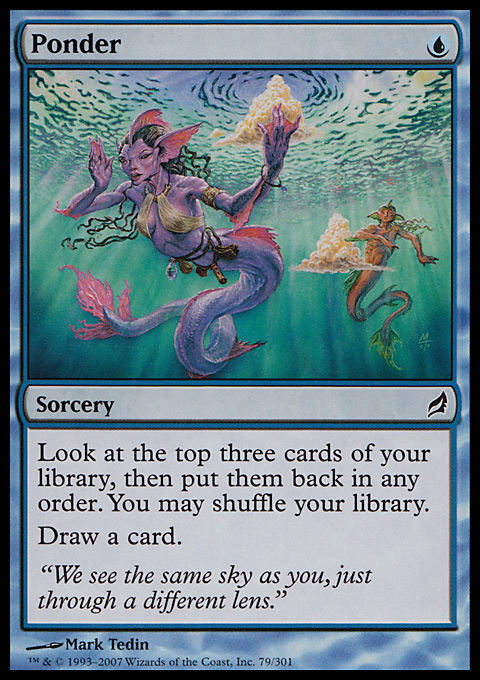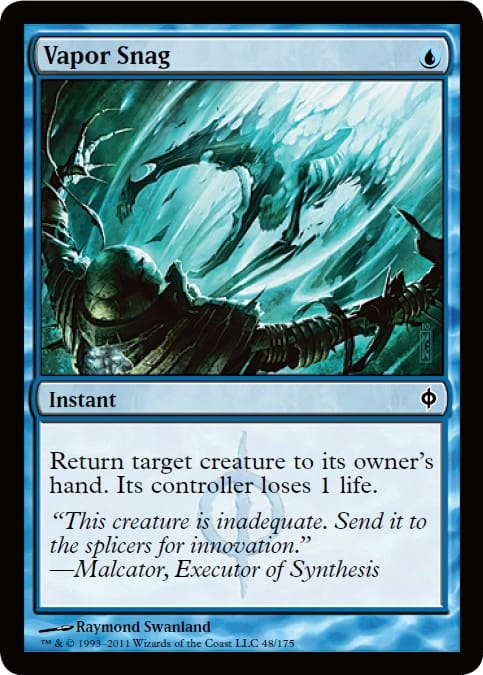Until recently the most feared turn one play in Pauper was Island into Delver of Secrets. That is not to say that a turn one Delver is bad — far from it — but it the deck it signals has assumed a different spot in the metagame. The mantle was hard earned and was based in rational thought. A turn one Delver of Secrets could signal anything from a hyper aggressive deck featuring Kiln Fiend and Temur Battle Rage to a Mono-Blue control deck that runs as many ways to say “No” as it can muster. Today, however, I want to focus on the deck that shares a name with the ever-present 1-drop.
Delver Blue, often shorthanded to Delver is the premier Blue deck in Pauper. It combines a rock solid mana base with efficient threats, strong card selection, and countermagic. The overarching goal of the deck is to stick a threat and disrupt the opponent so those creatures can connect — basic aggro-control deck. Delver often takes the role of a Skies deck in that it uses largely evasive threats to apply pressure. Over time the deck has evolved to include fewer lands as the quality of single-mana filer spells has gone up.
The first instance of the deck that would become Delver showed up in the second Pauper Premier Event. Way back in April 2009, the following deck ended up in 19th place out of 107 participants. Conflux was the most recent set available on Magic Online and many cards that would go on to be format staples were still absent. Yet the deck still has a number of similar elements.
Faerie Skies ? Pauper| Yakes604, 19th place, Pauper Premier Event, April 2009
- Creatures (27)
- 2 Pestermite
- 3 Faerie Squadron
- 3 Looter il-Kor
- 3 Shrieking Drake
- 4 Mothdust Changeling
- 4 Ninja of the Deep Hours
- 4 Spellstutter Sprite
- 4 Spire Golem
- Spells (13)
- 3 Brainstorm
- 3 Force Spike
- 3 Rushing River
- 4 Counterspell
- Lands (20)
- 16 Island
- 4 Lonely Sandbar
- Sideboard (15)
- 2 Gigadrowse
- 3 Moonglove Extract
- 2 Negate
- 3 Oona's Gatewarden
- 3 Remove Soul
- 2 Silvergill Douser
The above list runs more lands than the current versions of Delver and is missing the eponymous card (since it had not been printed yet). Instead the deck makes use of Mothdust Changeling and Faerie Squadron to hit the board early while enhancing the strength of Spellstutter Sprite. Ninja of the Deep Hours and Shrieking Drake allowed the pilot to reuse Spellstutter Sprite while also providing a chance to upgrade Faerie Squadron to Aven Windreader status. Pestermite and Rushing River are the primary tempo elements with Looter il-Kor connecting for hard to block damage while also filtering away excess lands.
Just over a month later an updated version of the deck managed to finish in the Top 8 of the next Premier Event. Gone were the Shrieking Drakes and Faerie Squadrons and instead we see a full complement of Pestermite and Ponder. The deck also adopted Boomerang as a more powerful bounce spell and Piracy Charm for pure utility.
Faerie Skies ? Pauper| bruttibler, 8th Place, Pauper Premier Event, May 2009
- Creatures (20)
- 4 Mothdust Changeling
- 4 Ninja of the Deep Hours
- 4 Pestermite
- 4 Spellstutter Sprite
- 4 Spire Golem
- Spells (19)
- 2 Boomerang
- 2 Remove Soul
- 3 Piracy Charm
- 4 Brainstorm
- 4 Counterspell
- 4 Ponder
- Lands (21)
- 19 Island
- 2 Lonely Sandbar
- Sideboard (15)
- 2 Annul
- 4 Hydroblast
- 2 Moonglove Extract
- 3 Negate
- 1 Piracy Charm
- 2 Relic of Progenitus
- 1 Rushing River
The most powerful addition is Ponder. Ponder and similar spells allow Delver to shave lands while not sacrificing overall card quality. The fact that Ponder has an upper bound of seeing four cards (over the three of Brainstorm and Preordain) make it an ideal spell at all points in the game. But there have been enough words written on these spells, and they are all more poignant.
Until the release of Delver of Secrets the Mono-Blue tempo deck always skirted the line of Faerie tribal. Cloud Sprite eventually found a home and Latchkey Faerie cycled in and out. Fathom Seer would be a steady inclusion early on before being supplanted by the awesomely powerful Gush (which had been online thanks to an early Duel Decks release).
Delver of Secrets gave the deck an incredibly powerful offensive threat on the first turn that pushed the deck more toward spells. The desire to have an early 3 power flyer led to including both Ponder and another similar spell to help facilitate enough creatures and spells and keeping the land count low. The early builds would run upwards of 20 lands but it is far more common to see 17 lands these days.
Delver was always a solid threat but it was the turn two play that helped cement it as one of the best decks in the format. Cloud of Faeries would provide a body that helped to enable a Spellstutter Sprite that could lock down just about any turn two play. That opening shut down so many decks that it helped to get Cloud of Faeries banned. One of the most successful pilots of the deck for many years ran a build that featured 21 lands and a slightly higher top end with Exclude.
Delver ? Pauper| Mezzel, 1st Place, Pauper Daily Event, August 11, 2013
- Creatures (22)
- 3 Phantasmal Bear
- 4 Cloud of Faeries
- 4 Delver of Secrets
- 4 Ninja of the Deep Hours
- 4 Spellstutter Sprite
- 3 Spire Golem
- Spells (19)
- 2 Exclude
- 2 Gush
- 3 Deprive
- 4 Brainstorm
- 4 Counterspell
- 4 Snap
- Sideboard (15)
- 4 Coral Net
- 4 Dispel
- 4 Hydroblast
- 3 Steel Sabotage
Just this year Cloud of Faeries was banned. While some feared that this would be the end of Delver as a deck it simply found a new 1-drop and continued its winning ways. Faerie Miscreant from Origins has the right creature type to turn on Spellstutter Sprite but also has the advantage of potentially replacing itself. In a deck with relatively few high quality threats the velocity provided by Miscreant gives Delver a different angle of attack from Cloud of Faeries. Cloud facilitated a free threat and board development while Miscreant can provide the setup for Spellstutter at the cost of leaving turn two alone. The switch (along with the card’s release in Eternal Masters) has prompted more people to run Daze. Today, the typical Delver deck looks something like this:
Delver ? Pauper| YourJudge, 5-0 in the Pauper League, October 20, 2016
- Creatures (20)
- 4 Delver of Secrets
- 4 Faerie Miscreant
- 4 Ninja of the Deep Hours
- 4 Spellstutter Sprite
- 4 Spire Golem
- Spells (23)
- 2 Daze
- 2 Deprive
- 2 Gush
- 4 Counterspell
- 4 Snap
- 4 Ponder
- 4 Preordain
- 1 Bonesplitter
- Lands (17)
- 17 Island
- Sideboard (15)
- 3 Annul
- 2 Aura Flux
- 2 Coral Net
- 2 Curfew
- 1 Curse of Chains
- 3 Hydroblast
- 2 Stormbound Geist
Recently there has been a major innovation in Delver decks. Spire Golem has been an automatic inclusion due to its strong stats and the ability to come down on the cheap. Scottish National Champion Stephen Murray decided to cut the Spire Golems for Phantasmal Bear while also dropping the land count to 15. This gives the deck a far more aggressive bend and forces it to lean harder on Snap and Vapor Snag.
Aggro Delver ? Pauper| Jecht Murray, 5-0 Pauper League, September 21, 2016
- Creatures (20)
- 4 Delver of Secrets
- 4 Faerie Miscreant
- 4 Ninja of the Deep Hours
- 4 Phantasmal Bear
- 4 Spellstutter Sprite
- Spells (25)
- 1 Brainstorm
- 1 Snap
- 2 Gush
- 3 Vapor Snag
- 4 Counterspell
- 4 Daze
- 2 Preordain
- 4 Gitaxian Probe
- 4 Ponder
- Lands (15)
- 15 Island
- Sideboard (15)
- 3 Annul
- 1 Coral Net
- 1 Curse of Chains
- 1 Dispel
- 3 Gut Shot
- 4 Hydroblast
- 2 Stormbound Geist
Regardless of these changes the most successful modern iterations of Delver all have some cards in common. First off are the lands: 15 copies of Island. While 17 was the standard for quite a while the innovations in aggressive builds of Delver mean that if you’re starting from scratch at least 25% of your maindeck need to be these lands.
Next up are the creatures. Nearly every build maxes out on Delver of Secrets, Faerie Miscreant, and Spellstutter Sprite. These represent Delver’s early game. A turn one Delver is still a good way to pressure an opponent’s life total while the Faeries help to keep cards flowing or staunching spells if needed. If Phantasmal Bear is included that usually means there will not be home for Spire Golem and the build is likely to trend toward the aggressive builds. Of note — some versions run Mutagenic Growth as a way to win in combat but the Phantasmal Bear builds almost never do due to the dissonance between the pump spell and their additional 1-drop.
Sometimes Delver decks will run Cloudfin Raptor as a way to produce another reasonable body in the latter stages of a game. While Cloudfin Raptor is a potent threat it is better suited for decks that are primarily creature based as that gives it the best chance of doing a Dragon impersonation. Raptor is not bad in Delver but the thing that makes Delver flip is not that same thing that grows Raptor, causing the deck to be pulled in disparate directions.
The top end of Delver usually includes at least copies of Ninja of the Deep Hours and three copies of Spire Golem (again, unless there are Phantasmal Bears). Most versions will run the full four copies of these creatures. Ninja is a reasonable body that also draws at least one card while allowing you to reuse a Spellstutter Sprite or Faerie Miscreant. While Ninja is a strong card each copy has a tendency to connect only once. Spire Golem is just one of the best creatures in the format thanks to its ability to come down at a reduced cost. A turn four Spire Golem for two means that the next spell coming is likely to be countered.
There are other creatures to consider for Delver. Jeskai Sage and Frostburn Weird have both seen play as aggressive 2-drops that can apply significant pressure. Ingenious Skaab fits this mold but has yet to breakthrough. At three Stormbound Geist provides a resilient threat while Pestermite is a flexible tempo based play that has the advantage of working with Ninja of the Deep Hours and Spellstutter Sprite. Eldrazi Skyspawner fits into this mold as well but it is better suited for Cloudfin Raptor decks or Delver builds that run Bonesplitter. While it is expensive some people opt to include a copy or two of Mulldrifter, which says more about the strength of the flying fish than anything else.
Next up are possibly the most controversial slots in Delver: the cantrips. Pauper has access to some of the best 1 mana Blue spells of all time (sorry Ancestral Recall) and there has yet to be a consensus on the Ponder-Preordain-Brainstorm configuration. In Delver I prefer to start on four copies of Ponder and then figuring out the rest. Most Delver decks run around 10 copies of these spells so the full suite of Preordain is what tends to follow with the final two slots being taken up by Brainstorm. Brainstorm is a powerful card that has the advantage of setting up Delver flips. That being said without fetchlands the best play is to follow up the Brainstorm enabled flip is Ponder to shuffle away potentially dead cards. Thought Scour has seen play in Delver decks that focus more on the graveyard with cards like Stitched Drake, Accumulated Knowledge, Think Twice, and Oona's Grace. In those builds I would consider running the full four copies of Brainstorm as the combination with Thought Scour can mimic “drawing” four cards. Finally there is the “free” Gitaxian Probe which has the advantage of helping to shrink your deck while providing additional information.
The counter suite starts with four copies of Counterspell. After that and Spellstutter Sprite things tend to vary. Daze and Force Spike are seeing more play than they have in the past. Again, Eternal Masters has given the online environment more copies of Daze and Force Spike, while not the same, does a fairly good impression. Beyond these soft counters decks have been leaning more on Deprive as an option that has more utility than say, Mana Leak, in the end stages of a game. Other counters that have seen play include Psychic Barrier, Nullify, Essence Scatter, and Remove Soul to handle creatures or Prohibit for more of a catch-all. Lately more copies of Dispel and occasionally Spell Pierce have earned slots in the 60 to help combat other Blue decks.
The tempo elements of Delver start with Vapor Snag and Snap. Snap, despite featuring the unfair “free" mechanic is merely very good in Pauper. Having an initial cost of 2 mana is a steep barrier in a land light deck like Delver. Vapor Snag is worse at saving your own creatures but has the advantage of piling on the damage. Boomerang, Echoing Truth, Into the Roil, and Withdraw all see play either in the 60 or the extra 15. Piracy Charm deserves a mention due to the fact it can pick off 1 toughness creatures while providing additional utility in the late game by either forcing a draw step discard or punching through the final points of damage.
Finally there is almost always a refuel element to Delver. Acting as a supplement to Ninja of the Deep Hours, the go to these days is Gush. After the initial development stages Gush is an absolute powerhouse thanks to its alternate casting cost. It is a common play to see someone float two Blue mana and then cast Gush digging for a Counterspell. Oona's Grace has fallen out of favor but provides another late game option that also makes use of excess lands.
Bonesplitter and Mutagenic Growth both see play as a way to pile on damage. In the past they have helped to give Delver decks an edge in the mirror (to trade with Spire Golem) and have allowed them to play on the more aggressive side of aggro-control. Thanks to the advent of Phantasmal Bear Delver these cards tend to see play in slower versions, if at all.
Looking forward Delver’s future remains as bright as its past. The cards that help to make the deck great are ones that will see print again. Cheap bounce and card filtering are not going away anytime soon and blue creatures with the creature type of Faerie are a when, not an if. While we may not be seeing another Ponder, Spire Golem, or Counterspell any time soon there is a good chance for more Phantasmal Bears and Faerie Miscreants. As long as there are cheap Blue cards available, Delver will persist.













